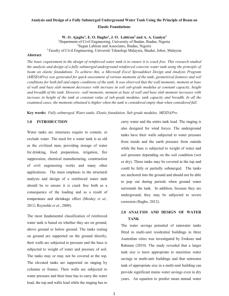
Underwater construction 1995 - 2015

Abstract:
The paper describes the offshore operations and
associated engineering - riser base and umbilical arch
installation, surface tow, upending, docking, deballasting,
etc. - that led to the successful installation of the three
riser towers in the deepwater environment of the Girassol
field. The paper concludes on the feasibility of installing
riser towers in different field environments.

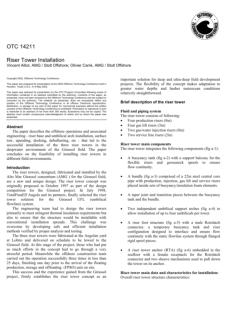

This document describes the method for installing hybrid
riser towers, composed of upper and/or lower portions
("jumpers") made of flexible conduit and suitable for deep
and ultra-deep water field development.



This investigation describes a new coupler device that can
be used to monitor underwater pipelines using guided
waves. Underwater pipeline inspections were conducted
using ultrasonic cylindrical guided waves in the laboratory
environment. Three different types of mechanical defects:
gouge, removed metal, and dent, were fabricated in
small-diameter, 22.22-mm aluminum pipes and tested. A
new transducer holding device was designed to efficiently
propagate the antisymmetric (flexural) cylindrical guided
waves through the aluminum pipe in water. The
instrument used commercially available ultrasonic
transducers that generate compressional ultrasonic waves
in the water.

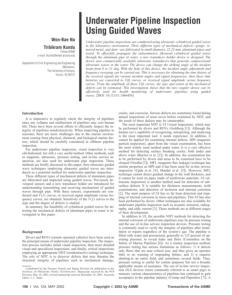

The multiple-lines hybrid riser tower concept, first applied
in the late 1980s in the Gulf of Mexico is now being used
more widely on other deepwater projects.
This paper presents the lessons learned from the hybrid
riser tower design applied to meet the requirements of
deepwater field developments.

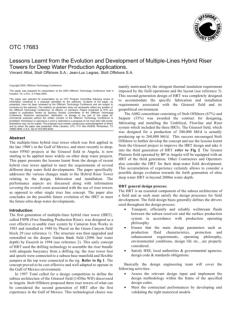

Seaflow has been a project to develop and test a
commercially-sized marine current turbine. The turbine
was installed in the summer of 2003 off Foreland Point,
near Lynmouth on the North Devon coast of England.
The objectives of the project were to test the feasibility of
constructing and operating such a machine, to ascertain
whether the performance would be as predicted, and
evaluate the likely longer-term economics of using such
tidal turbines to generate electricity.

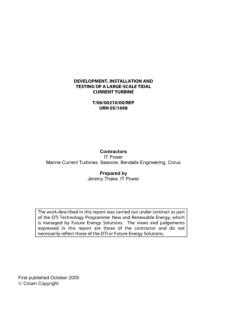

The interest in towing techniques for installing flowlines
and risers has increased in recent years, particularly for
deep-water field developments. Surface tow presents
particular interest, although it is more delicate to engineer
compared to other towing methods. This paper presents
experimental data and feedback from surface towing trial
operations performed by Acergy.
Note that Acergy and Subsea 7 merged in January 2011.
The new structure operates under the name "subsea 7".






This paper provides an overview of various support
options available for wind turbines like gravity base
structure, monopiles, suction caissons, tripod/tetrapod
with caissons, floating platform, and jacket structure. For
all available options, the current status of use and
development for all available options, future need for
research, advantages, and disadvantages as discussed.
Also, a comparison of all foundation systems is made to
choose one according to site conditions.

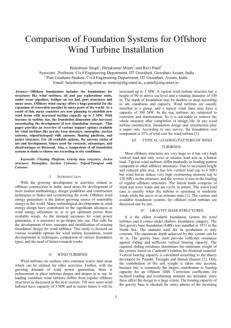


This paper provides an overview of the research
conducted during a tidal turbine deployment off the
Welsh coast. The Bristol Channel was chosen because of
its high tidal flows and proximity to national grid
connections and support infrastructure.

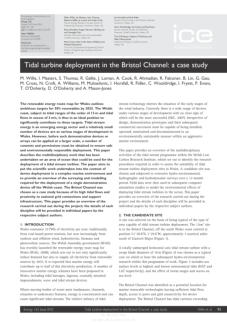


The O-lay offshore pipelay method is a concept for
offshore pipeline and girth welded riser installation which
has many advantages compared with traditional
installation methods. The method uses an onshore
construction yard in which the pipeline is produced, then
wound in a flat monolayer spiral floating on the water,
and finally towed to the location to be installed with the
help of a simplified lay barge.

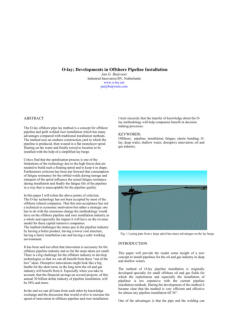


MARINET (Marine Renewables Infrastructure Network for
Emerging Energy Technologies) is an EC-funded network
of research centres and organizations working together to
accelerate the development of marine renewable energy -
wave, tidal & offshore wind.
This initiative consists of five main Work Package focus
areas: Management & Administration, Standardisation &
Best Practice, Transnational Access & Networking,
Research, Training & Dissemination.
The aim is to streamline the capabilities of test
infrastructures in order to enhance their impact and
accelerate the commercialisation of marine renewable
energy.



Hydro energy, wind energy, and solar energy will be
mainly utilized in Indonesia to fulfill the energy of remote
villages and remote islands and optimize the domestic
energy availability. Regarding the small-scale field research
conducted during 2012 and 2013 in Indonesia,
transmission systems and low rpm alternators
encountered significant problems during the
development of the hydro and wind turbine engines.

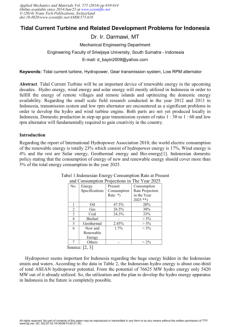


This paper presents the tidal stream turbine types and
some information about current and future power
stations.
Tidal current technologies have advantages over fossil
energy: They are cleaner and provide security and
diversity of supply with limited social and environmental
impacts. Their main inconvenience is that they provide
intermittent power. However, this is predictable, and so
this problem can be controled.

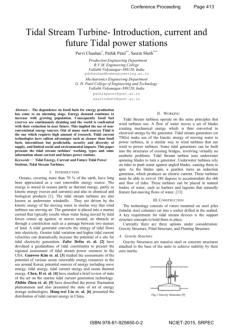

This paper describes the application of Computational
Fluid Dynamics techniques to model tidal turbine wakes.
Results for both one turbine alone and two turbines
positioned in tandem are included.

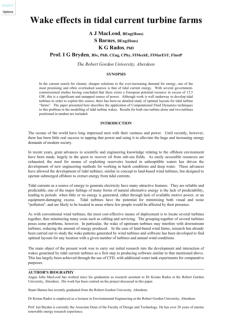

Among the many ocean energy technologies under
development, the tidal turbine farm has been proposed
as an environmentally friendly ocean energy converter
application.
Although the technology and capital costs of ocean
energy turbines are understood, the economics of
operating a gang of turbines as an energy farm has yet to
be analyzed. In this paper, a planning, operation, and
maintenance model for tidal turbine farms are proposed.
The system is modeled using life-cycle assessment,
incorporating a variety of time-dependent variables.
Model components include farm construction and
planning, operation strategy, regular maintenance, and
emergency maintenance. Preliminary numerical
simulation results are shown in a case study for a potential
site.

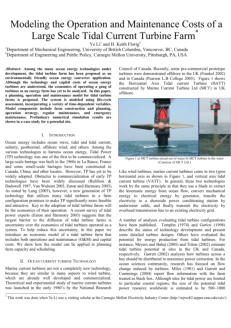

The EPRI North American Tidal In-Stream Energy
Conversion (TISEC) Power Project demonstrates the
feasibility of tidal current power to provide efficient,
reliable, environmentally friendly, and cost-effective
electrical energy and create a push towards the
development of a sustainable commercial market for this
technology. This project is being conducted by a team
consisting of the Electric Power Research Institute (EPRI),
EPRIsolutions, a subsidiary of EPRI, Virginia Tech, the
University of Washington, Mirko Previsic (private
consultant), Devine Tarbell and Associates (TDA), and the
Department of Energy’s National Renewable Energy
Laboratory (NREL), herein referred to as “the Project
Team.”

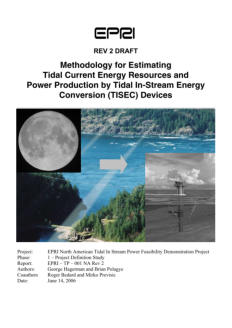

This project has attempted to identify and quantify the
trade-offs between reliability, efficiency, and cost of
generic horizontal axis tidal turbines (HATT). The overall
economic performance will depend to a varying extent
on all aspects of the installation, operation, maintenance,
and decommissioning approaches adopted.


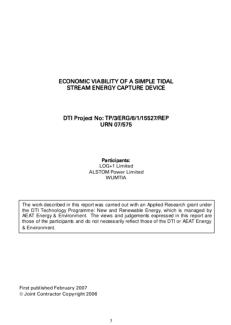


This report considers the potential advantages associated
with the third generation tidal turbines.
To highlight this potential, the author looks closely at one
example – the MREV turbine developed at Exeter
University with funding support from BERR (Department
for Business Enterprise and Regulatory Reform).

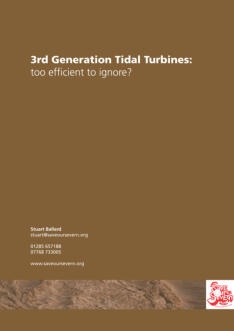


The United States of America Department of Energy’s
(DOE) Federal Energy Management Program (FEMP)
facilitates the Federal Government’s implementation of
sound, cost-effective energy management, and
investment practices to enhance the nation’s energy
security and environmental stewardship. FEMP works to
reduce the cost and environmental impact of the Federal
Government by advancing energy efficiency and
promoting the use of distributed and renewable energy
at Federal sites. The overall goal is to lower Federal fossil-
fuel energy consumption to reduce environmental and
national security risks. This goal is supported by renewable
energy and energy efficiency mandates as set forth in the
Energy Policy Act of 2005 (EPAct 2005), Energy
Independence and Security Act of 2007 (EISA 2007), and
other Federal regulations.

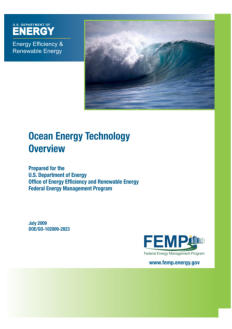


The purpose of this report is to get an overview of the
existing technology of water current turbines with a
unit power output of about 0.5-5 kW.





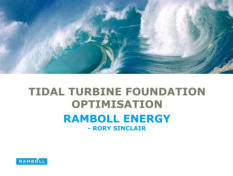
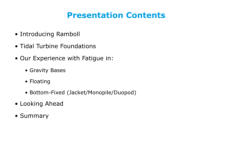


This thesis reviews the physical principles of tidal energy
considering gravitational effects of sun and moon,
semidiurnal, diurnal, and mixed tides, and periodic
phenomena that affect tidal range. Moreover, an up-to-
date review of the status of tidal energy technology is
included. Furthermore, the different tidal conversion
systems are introduced, tidal barrage and tidal stream
turbines. The current issues for both technologies are
presented, aiming to place the reader on the current
situation. The thesis also contains an economic
assessment, where the current costs of both technologies
and an estimation of the future costs are shown.




Although not yet widely used, tidal power has the
potential for future electricity generation. Tides are more
predictable than wind energy and solar power. Among
sources of renewable energy, tidal power has traditionally
suffered from relatively high cost and limited availability of
sites with sufficiently high tidal ranges or flow velocities,
thus constricting its total availability. However, many
recent technological developments and improvements,
both in design (e.g., dynamic tidal power, tidal lagoons)
and turbine technology (e.g., new axial turbines, cross-
flow turbines), indicate that the total availability of tidal
power may be much higher than previously assumed and
that economic and environmental costs may be brought
down to competitive levels.

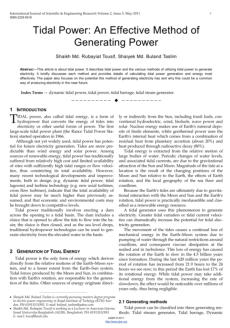


This project set out to make the initial design proposal of a
2 x 4 meter H-shaped Darrieus turbine by applying the
Double Multiple Streamtube model. The optimization
process was performed with the aid of MATLAB for four
different foils. The study included two symmetrical foils;
NACA 0012 and S-1046, together with two asymmetrical
foils; S-1210 and E216. The parameters studied were the
number of blades, chord length, tip speed ratio, fixed
pitch, and operational range. Effects such as blade to
wake interaction, torque fluctuations, etc., were also
considered.

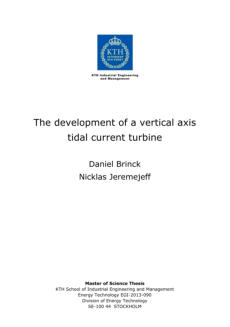


This paper deals with the control strategies for a fixed-
pitch Marine Current Turbine (MCT) when the marine
current speed exceeds the rated value corresponding to
the rated power of the generator and converter. Over-
rated marine currents occur at large spring tides or under
strong sea states; in these cases, Maximum Power Point
Tracking (MPPT) strategies must be changed to power
limitation strategies for limiting the generator power at
rated value.
Two power limitation strategies are investigated in this
study.

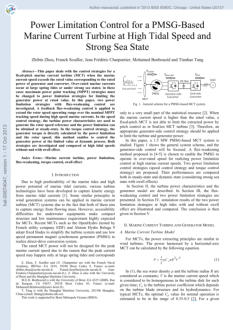
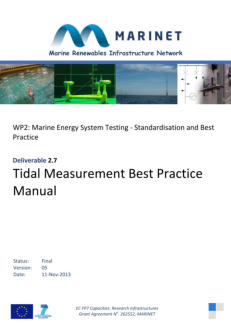


The International Renewable Energy Agency (IRENA) is an
intergovernmental organization that supports countries in
their transition to a sustainable energy future and serves
as the
the principal platform for international co-operation, a
centre of excellence, and a repository of renewable
energy policy, technology, resource, and financial
knowledge.
IRENA promotes the widespread adoption and
sustainable use of all forms of renewable energy,
including bioenergy, geothermal, hydropower, ocean,
solar, and wind energy.




This paper describes the structural design of a tidal turbine
composite blade. The structural design is preceded by two
steps: hydrodynamic design and determination of
extreme loads.
The hydrodynamic design provides the chord and twist
distributions along the blade length that result in optimal
performance of the tidal turbine over its lifetime.
The extreme loads, i.e., the extreme flap and edgewise
loads that the blade would likely encounter over its
lifetime, are associated with extreme tidal flow conditions
and are obtained using computational fluid dynamics
(CFD) software

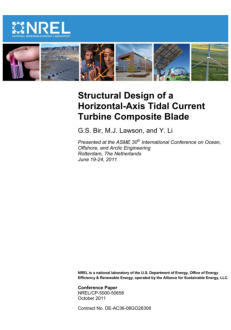


Certification according to this service specification is a
procedure by which DNV GL gives written assurance that
a product design, manufacturing, commissioning,
operation, and maintenance processes or services,
conform to requirements specified in this service
specification.




Britain’s Bristol Channel and adjoining Severn estuary
together form a long and funnel-shaped area of sea,
causing the tidal range to increase from a maximum of 7
m at the outer reaches to about 14 m at Avonmouth. This
is the second highest tidal range in the world. There is,
thus, considerable energy locked up in the tidal excursion.
Tidal energy can either be harnessed by damming a
portion of the estuary and using the subsequent head
differential to generate power from the tidal range or else
having turbines underwater in the sea, similar to wind
turbines, developing energy from the flow of the tidal
currents. This paper looks at the various ways the tidal
energy from the Severn estuary/Bristol Channel could be
harnessed. This paper thus provides an overview of the
Severn estuary as a tidal energy source, including the
potential schemes, their issues, and their benefits.



Author: Sanjeev Malhotra.
This document explains foundation systems commonly
used to install wind turbines in shallow fields.
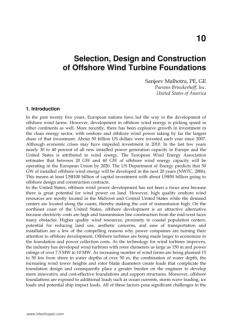

This paper presents research regarding the control valves'
modeling and simulation. Also, because control valves are
complex structures, The authors provide a mathematic
model that may be utilized to verify the characteristic of a
control valve for all operating points.

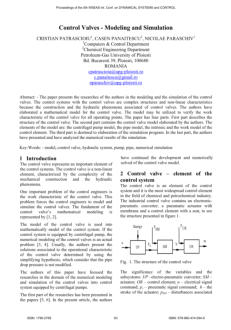

TThis paper gives an overview of wave energy converters
(WEC) instead of ocean current energy converters.




This paper, written in 2012, describes air turbines that
could be used for wave energy conversion. The overall
performances of the turbines are compared by numerical
simulation and sea trial.




This document, written in 2012, provides a brief history of
wave energy conversion systems from 1799 to 2012.

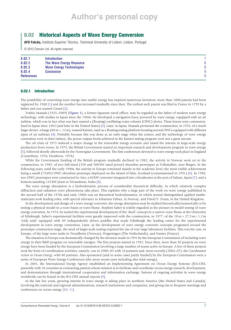

This paper presents an investigational study on Wave
Energy Converters (WECs). Design considerations for
implementing them in the Gulf of Mexico are also
evaluated.

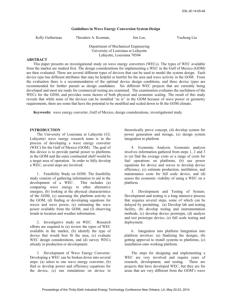

This document is the US Patent file for a system to convert
kinetic wave energy from a dynamic fluid into electrical
power through a piezo kinetic assembly,

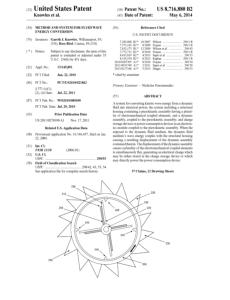

This document, written in 2014, is another presentation of
the various wave energy convertion systems.

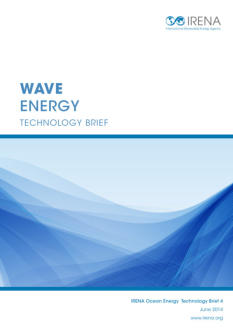

This document is another US Patent file regarding a
system for using wave energy on offshore, nearshore, or
onshore facilities.



This document can be seen as a complementary study of
the others available on the website regarding the
development of air turbines for wave energy conversion.
The authors review several solutions starting from
conventional turbines to self-rectifying units.

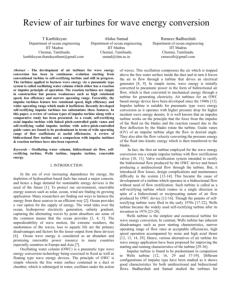

Inventors: De Oliveira Falcao, De Carvalho Gato, & De
Campos Henrique
This document is the international patent file of an air
turbine capable of, without changing its rotational velocity
direction, efficiently absorbing the energy associated with
pressure differences that successively change sign, as in
the case of some sea wave energy conversion systems.

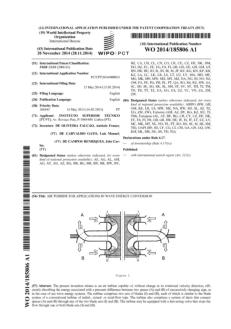

This study discusses selected technical solutions
generating electricity from waves. The research of the
Maritime University of Szczecin, Poland, regarding wave
energy conversion into electricity and using coast
protection against waves are presented. The potential of
waves as a renewable energy source (in Europe and
outside) is also evaluated, and the problems that may be
encountered are outlined.




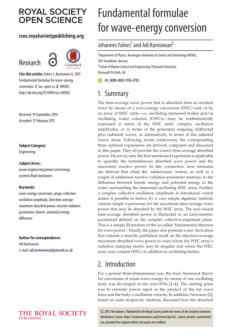
This invention is based on a structure driven by floats for
converting Wave energy into electricity. The structure
comprises a floating body to float and stabilizes the
structure in the water, wherein a platform is provided to
house and hold energy conversion systems and
mechanisms.


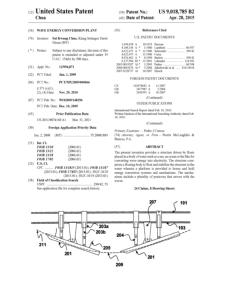



Sea fastening must be laid out to cope with the maximum
operating transit criteria for H; this is important for the
transit criteria. If this is
low, the operational envelope is also low. Therefore, the
designer, typically the naval architect, will look at the
maximum g-force the turbine components will allow in
any direction. This will be the governing parameter for the
sea fastening.
The operational envelope and the maximum g-forces on
the components are then determined by the vessel
motion and the corresponding maximum sea state in
which they occur.

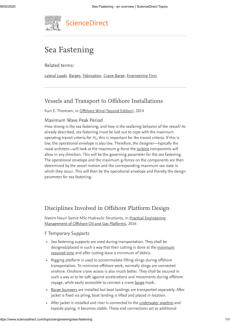

An original workgroup comprising ASCO, BP Amoco
(now BP), Gulf Offshore, Seaforth Maritime, Shell, Swire
and Texaco was established by the Marine Safety Forum
(MSF) to consider the hazards and risks associated with
the safe packaging and handling of cargo to and from
offshore installations. The objective of the workgroup was
to identify areas where additional guidance would help to
secure improvements in safety.

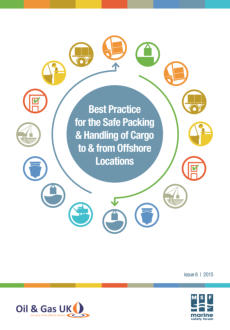

This paper presents a finite element analysis of the force
required to lift objects embedded in cohesive seafloor
sediments. The behavior of the soil is described by a
broadly applicable time-dependent constitutive model for
cohesive soils. The validity of the numerical solution is
evaluated by comparing the calculated breakout force
with predictions obtained from some available empirical
and analytical equations.




In the past twenty-five years, European nations have led
the way in developing offshore wind farms. However,
offshore wind energy development is also picking up
speed in other continents. More recently, there has been
explosive growth in the clean energy sector investment,
with onshore and offshore wind power taking by far the
largest share of that investment. About 50 billion US
dollars have been invested each year since 2007.
Although economic crises may have impeded investment
in 2010, in the last few years, nearly 30 to 40 percent of all
newly installed power generation capacity in Europe and
the United States is attributed to wind energy.

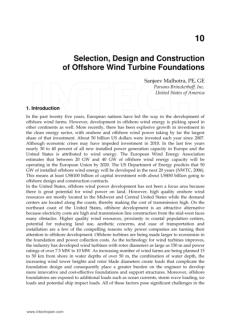

Offshore geotechnical engineering is closely connected to
onshore practice, but it tends to diverge due to the
different scales of the foundations and fundamental
differences in installation techniques. The stiffness of the
structure compared to the stiffness of the soil is by many
orders higher in the case of offshore foundations – mud
mats, suction piles, spud cans, and large monopiles. It is
possible to define the behavior of these structures as the
behavior of a rigid body with six degrees of freedom and
to apply forces to the reference point.

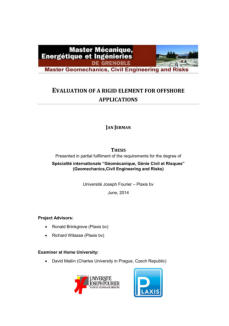

Authors: Kimberlie Staheli, David Bennett, Hugh W.
O'Donnell, and Timothy J. Hurley.
This document was published by the US army corps of
engineers.
In the early 1970's a new process was introduced to install
pipelines by use of horizontal directional drilling (HDD)
techniques. The method has steadily grown to achieve
worldwide acceptance. Today pipeline installations
increasingly rely upon HDD technology as the primary
method for crossings of watercourses, wetlands, utility
corridors, roads, railroads, shorelines, environmental areas,
and urban areas.




Authors: kshaykumar Ardeshana, Jayeshkumar Pitroda,
J.J.Bhavsar
This paper provides information on tunnels and
various tunneling operations involved to make tunnel and
also provide information related to old methods of
tunneling and new methods of tunneling using
ultramodern technology. Some case studies are also there
related to the modern technology used tunnel
construction
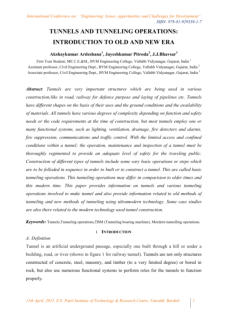


Artificial intelligence is a branch of computer science
involved in intelligent computer research, design, and
application. Traditional methods for modeling and
optimizing complex structural systems require vast
computing resources. It can provide valuable alternatives
for efficiently solving problems in civil engineering.
This paper summarizes methods and theories in the
developing direction for applications in civil engineering,
including evolutionary computation, neural networks,
fuzzy systems, expert systems, reasoning, classification, and
learning at the publication date (2012).

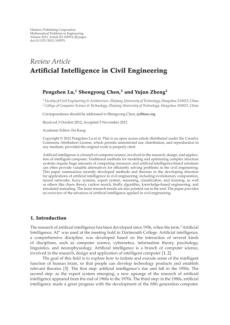



Click on the
octopus to return to
the top of the page


Authors: D.J. Rozene, E. Van Draege
The Unified Facilities Criteria for Maintenance of
Waterfront Facilities (UFC 4-150-07) covers a range of
techniques for repairing and maintaining underwater
steel structures affected by ALWC. This document
enhances UFC 4-150-07 by introducing a system for the
quick inspection, repair, and maintenance of submerged
parts of waterfront structures, such as steel sheet piling on
bulkheads. It utilizes a mobile cofferdam to access
underwater steel structures in a dry environment.




Publisher: US Army corp engineers, Naval facilities
engineering command, & Air force civil
engineering support agency
The Unified Facilities Criteria (UFC) system establishes
standards for planning, design, construction,
maintenance, renovation, and modernization. It is a guide
for the Military Departments, Defense Agencies, and all
Department of Defense (DoD) field activities, as outlined
in the USD (AT&L) Memorandum dated May 29, 2002.
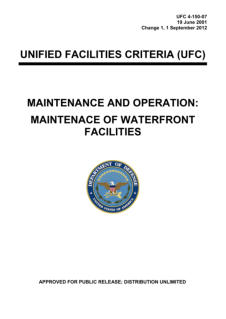


Author: Iris D. Tommelein
This paper highlights the issues caused by mismatches
due to delays and uncertainties in material supply and
prerequisite work completion. A model illustrates these
challenges and explores different sequencing alternatives
for material delivery and work area completion. It
compares the impact of total lack of coordination, perfect
coordination, and the use of lean construction techniques
like pull-driven scheduling on process execution, materials
staging buffers, and construction progress.

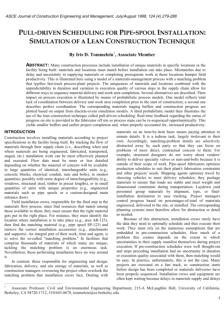

Authors: Landris T. Lee, Jr., and Richard W. Peterson
This document from the U.S. Army Corps of Engineers
details the historical evolution of underwater foundation
techniques, from ancient methods to modern
engineering practices, explains the technological
advancements and materials used in underwater
foundation construction over time, places the work of the
U.S. Army Corps of Engineers within the broader context
of underwater foundation engineering, highlighting their
role and the importance of state-of-the-art techniques, and
underscores the challenges and developments in
underwater foundation technology compared to onshore
applications.

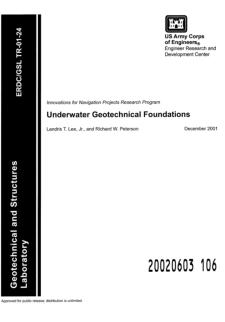

Author: Kabir Sadeghi
This paper overviews and reviews various aspects of the
selection, planning, design, fabrication, transportation,
installation, and commissioning of offshore structures,
particularly petroleum platforms. It offers a general
understanding of the stages involved in these processes
and proposes suitable types of offshore platforms for
different sea-water depths, specifically for installations in
Cyprus.





Authors: Labban R, Abourizk S, Haddad Z, El-Sersy A
This paper explains the effectiveness of computer
simulation methods in managing large and complex
construction operations. It highlights how simulation
models can be used to design and analyze construction
processes, test different scenarios, estimate resource
utilization, identify bottlenecks, and forecast time and cost
requirements. Additionally, it introduces a specific example
of a pipe spool fabrication model built by Consolidated
Contractors Group (CCC).

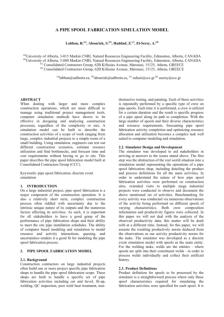


Authors: Alain Michel Jules Norro, Bob Rumes, and Steven
Johan Degraer
This document intends to compare the underwater noise
generated during the piling activities of steel monopiles
and jacket pinpiles used in offshore wind farms in the
Belgian part of the North Sea, providing a detailed analysis
of the noise levels, including zero to peak sound pressure
level (Lz-p), unweighted sound exposure level (SEL),
cumulative SEL, and 1/3 octave spectra, measured at
various distances from the pile driving location. It also
discusses the duration of piling activities and the potential
behavioral disturbance to marine life.

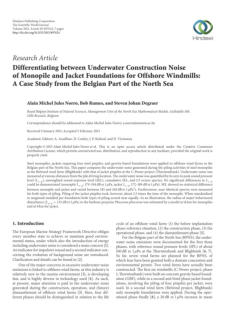

Authors: W. O. Ajagbe, E. O. Ilugbo, J. O. Labiran, and A.
A. Ganiyu
This paper describes a research study focused on
analyzing and designing a fully submerged underground
reinforced concrete water tank using the beam-on-elastic
foundations principle to ensure it remains crack-free. It
also discusses the development of a Microsoft Excel
Spreadsheet Design and Analysis Program (MESDAPro)
for quick assessment of various structural moments,
geometrical features, and soil conditions of the tank in
both full and empty states. Additionally, it highlights how
different factors, such as soil subgrade modulus and tank
height, affect the moments experienced by the tank.

